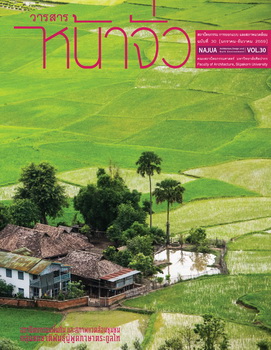ความสัมพันธ์ของพื้นที่ในเรือนชุมชนช่าง เมืองเชียงตุง
คำสำคัญ:
หมู่บ้านชุมชนช่าง, ความสัมพันธ์ของพื้นที่, การจัดการพื้นที่, เมืองเชียงตุง, Craftsmen village, Spatial relationship, Spatial organization, Kengtungบทคัดย่อ
บทความนี้มุ่งศึกษาความสัมพันธ์ของการจัดการพื้นที่ของชุมชนช่างในเมืองเชียงตุงในฐานะศูนย์กลางการค้าและฐานการผลิตสินค้าในภูมิภาคอาเซียน วัตถุประสงค์ของการวิจัยคือ ศึกษาความสัมพันธ์ของที่ตั้งของหมู่บ้านแต่ละชุมชนช่างกับเมืองเชียงตุงในฐานะที่เป็นฐานการผลิตสินค้าและการจัดการพื้นที่เรือนของชุมชนช่างในการผลิตสินค้าร่วมกับพื้นที่อยู่อาศัย งานวิจัยนี้เป็นการวิจัยเชิงคุณภาพ ใช้การสำรวจ การสังเกตอย่างมีส่วนร่วมและการสัมภาษณ์เชิงลึก การนำพิกัดของแต่ละหมู่บ้านและผังเรือนมาถอดรหัสของพื้นที่ และจัดกลุ่มของแต่ละประเภทการจัดการพื้นที่ ผลการศึกษาพบว่า ที่ตั้งของแต่ละชุมชนช่าง มีการตั้งถิ่นฐานตามลักษณะภูมิประเทศ สภาพแวดล้อมที่มีวัตถุดิบในการผลิตสินค้า และเส้นทางสัญจรที่ส่งผลดีในการค้าขาย การจัดการพื้นที่การผลิตสินค้าในตัวเรือนร่วมกับพื้นที่อยู่อาศัยของแต่ละหมู่บ้านขึ้นอยู่กับกระบวนการผลิตสินค้าแต่ละประเภทที่มีความเฉพาะตัวแตกต่างกัน มีทั้งการใช้พื้นที่ผลิตสินค้าร่วมกับพื้นที่พักอาศัยและแยกเฉพาะออกจากตัวเรือน พื้นที่นี้ทำให้เกิดเอกลักษณ์ของแต่ละชุมชนช่างในมิติทางพื้นที่ โดยมีองค์ประกอบของสินค้า เครื่องมือ ที่ประกอบอยู่ในหมู่บ้านชุมชนช่างเป็นตัวแสดงเอกลักษณ์ทางพื้นที่
Spatial organization in the houses of Artisan Villages in Kengtung
Pandin Ounchanum
Faculty of Architecture, Chiangmai University
This article discusses the relationship of spaces in artisan villages in Kengtung, which is a trading and production center of many goods. The objectives of this study are to look at the relationship between the location of each village with regards to Kengtung being a production centre, and the organization of spaces for living and working in the homes. This is a qualitative research based on surveys, participation, observation, and in-depth interviews. The location of villages and plan of houses were documented and analyzed. Results show that the villages are located according to the topography in areas that have abundant raw materials and transport routes with good trading potential. The arrangement of working and living spaces in each village depends on the production process that differ for each product. There are those that share working and living spaces, as well as those in which the working area is separated from the house. On the whole, this, along with the objects and instruments involved in the production process that are in sight, gives each village its unique identity.





